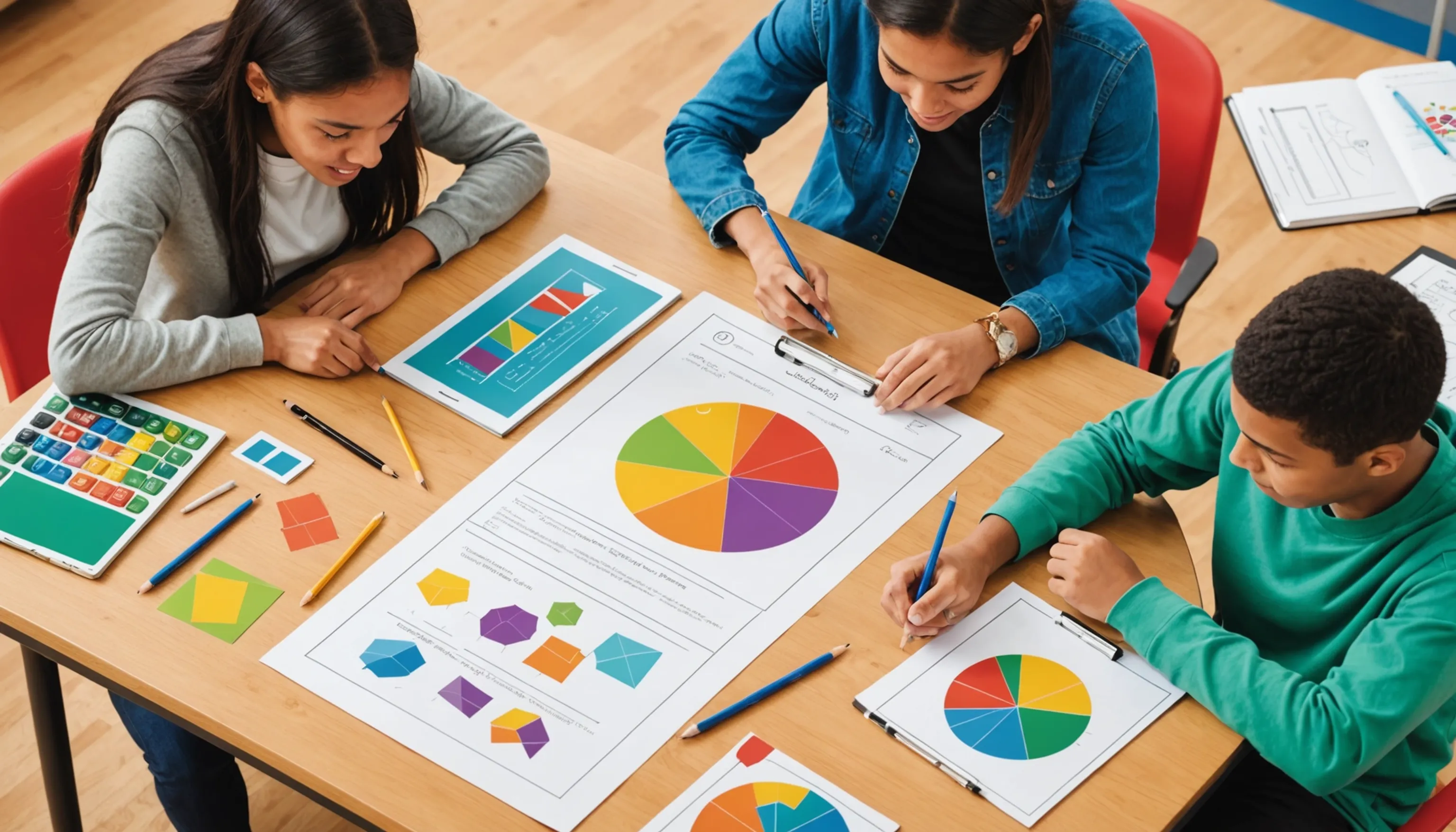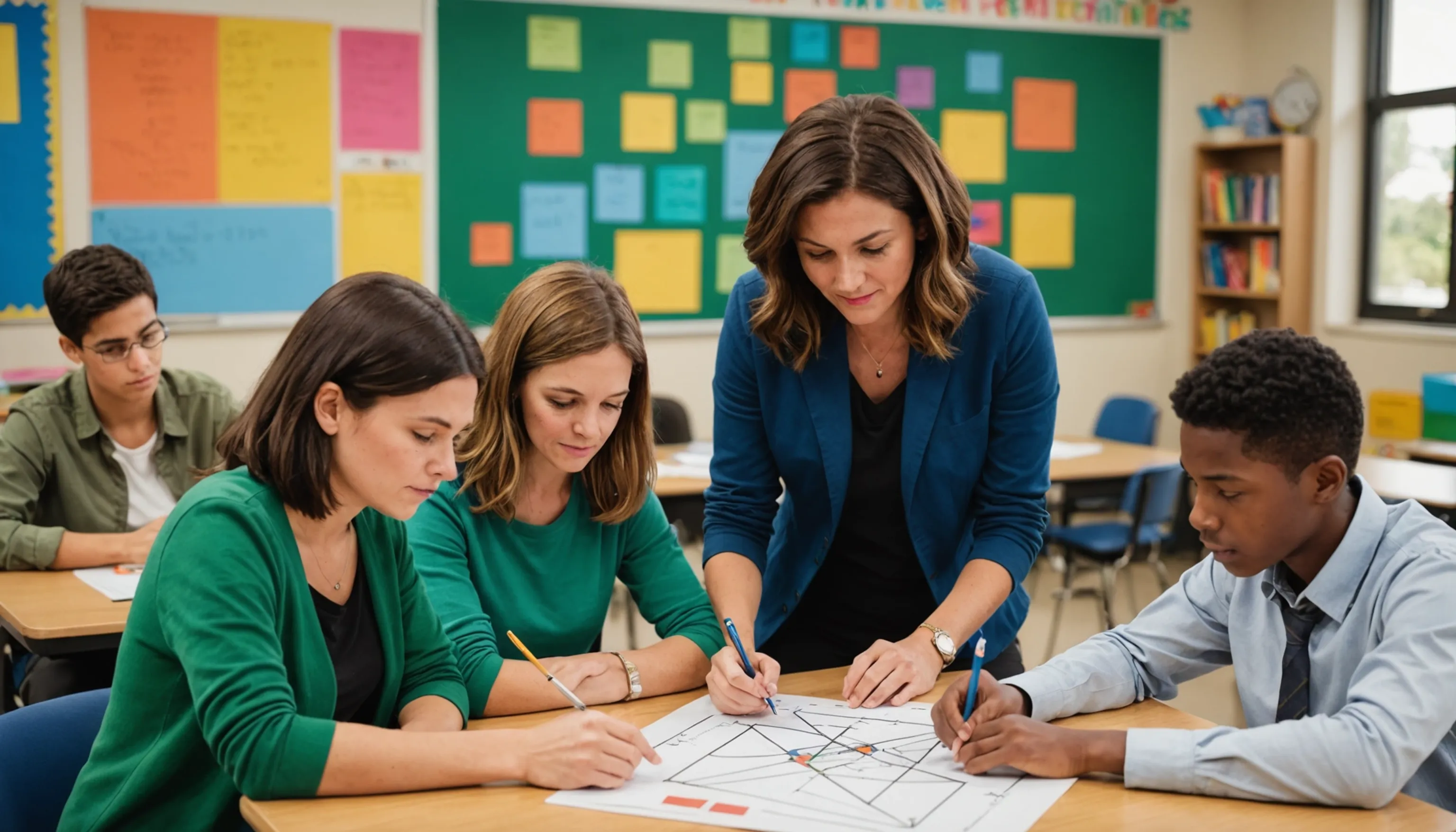Understanding Geometry for Parents and Teachers
 HvWHenry van Wagenberg
HvWHenry van Wagenberg
Understanding Geometry: A Guide for Parents and Teachers
Understanding geometry is crucial for parents and teachers who guide teenagers in their educational journey. Geometry, a branch of mathematics, focuses on the study of shapes, sizes, and the properties of space. It forms a foundation for various practical applications in everyday life, from architecture to engineering.
This guide aims to empower parents and teachers with the knowledge to support their teenagers. By grasping fundamental concepts and encouraging a positive learning environment, adults can help students appreciate the beauty and utility of geometry, making math less intimidating and more engaging.
What is Geometry?
Geometry is a significant branch of mathematics that deals with the study of shapes, sizes, and the properties of space. It encompasses various concepts, including points, lines, angles, surfaces, and solids. Geometry can be traced back to ancient civilizations, with the earliest records found in Egyptian and Babylonian cultures, where it was used for practical purposes like land measurement and construction.
At its core, geometry is divided into two main categories: Euclidean geometry and non-Euclidean geometry. Euclidean geometry, named after the ancient Greek mathematician Euclid, focuses on flat surfaces and follows the familiar postulates and theorems, such as the Pythagorean theorem. Non-Euclidean geometry, on the other hand, explores curved surfaces and more complex structures, which have become essential in modern physics and advanced mathematics.
One of the primary reasons geometry is important is its real-world applications. From architecture to engineering, geometry helps us understand spatial relationships and design structures. In addition, geometry plays a vital role in fields such as computer graphics, robotics, and even art.
For teenagers, grasping the concepts of geometry is essential not only for academic success but also for developing critical thinking and problem-solving skills. By understanding the principles of geometry, students can apply mathematical reasoning to various challenges, setting a solid foundation for future learning.
Importance of Geometry in Education
The importance of geometry in education cannot be overstated. As a fundamental branch of mathematics, geometry provides students with essential skills and knowledge that extend beyond the classroom. It lays the groundwork for critical thinking, problem-solving, and spatial awareness, all of which are valuable in everyday life.
First, geometry encourages logical reasoning. Students learn to make deductions based on the properties of shapes and the relationships between angles. This type of analytical thinking is crucial not just in mathematics, but in various fields, including science, engineering, and technology. For instance, when designing a structure, understanding geometric principles ensures that buildings are safe and efficient.
Additionally, geometry enhances spatial visualization skills. Students develop the ability to visualize and manipulate objects in space, an essential skill in careers such as architecture, graphic design, and aerospace engineering. A study by the National Council of Teachers of Mathematics highlights that students who excel in geometry often perform better in other math-related subjects.
Moreover, geometry fosters creativity. It allows students to explore artistic representations of shapes and patterns, linking mathematics with art and design. Through projects and hands-on activities, students can experience geometry in a fun and engaging way, making the subject more relatable.
In conclusion, geometry is a vital component of education that equips students with critical skills, prepares them for various career paths, and enriches their understanding of the world around them.
Key Concepts in Geometry
Key concepts in geometry form the foundation for understanding this branch of mathematics. Among these concepts are:
- Points: The most basic unit, representing a location in space.
- Lines: Straight paths extending infinitely in both directions, defined by two points.
- Angles: Formed by two intersecting lines, measured in degrees.
- Shapes: Two-dimensional figures like triangles, squares, and circles, each with unique properties.
- Solids: Three-dimensional objects, including cubes, spheres, and pyramids.
Understanding these key concepts is essential for mastering geometry.

Shapes and their Properties
In geometry, understanding shapes and their properties is crucial for developing spatial awareness and mathematical reasoning. Shapes can be categorized into two main types: 2D shapes (two-dimensional) and 3D shapes (three-dimensional). Each category has its own unique characteristics and properties.
Starting with 2D shapes, the most common include:
- Triangles: A polygon with three sides and three angles. The sum of the interior angles always equals 180 degrees. Triangles can be classified into different types: equilateral, isosceles, and scalene, based on the lengths of their sides.
- Quadrilaterals: A polygon with four sides, including rectangles, squares, trapezoids, and parallelograms. Each type has specific properties related to the lengths of sides and angle measures.
- Circles: A round shape defined by all points equidistant from a center point. Key properties include radius, diameter, and circumference.
In contrast, 3D shapes include objects such as:
- Cubes: Six equal square faces, with 12 edges and 8 vertices.
- Spheres: A perfectly round 3D shape with no edges or vertices.
- Cylinders: Two circular bases connected by a curved surface.
Understanding these shapes and their properties helps students recognize patterns, solve problems, and appreciate the role of geometry in the world around them.
Angles and their Measurements
Angles are a fundamental concept in geometry, representing the space between two intersecting lines or rays. Understanding angles and their measurements is crucial for solving various geometric problems and applying mathematical concepts in real-life situations.
Angles are typically measured in degrees (°), with a full circle comprising 360 degrees. There are several types of angles, categorized based on their measures:
- Acute Angles: Angles that measure less than 90 degrees. These angles are often seen in triangles and can create sharp corners.
- Right Angles: Angles that measure exactly 90 degrees, representing a quarter of a full circle. Right angles are commonly found in squares and rectangles.
- Obtuse Angles: Angles measuring more than 90 degrees but less than 180 degrees. These angles appear in various polygons and shapes.
- Straight Angles: Angles that measure exactly 180 degrees, forming a straight line.
- Reflex Angles: Angles measuring more than 180 degrees but less than 360 degrees, often seen in complex shapes.
To measure angles, tools like protractors are commonly used. Students can also learn to recognize angles visually, which helps in understanding their properties and relationships in different geometric contexts. Mastering angles and their measurements is essential for students, as it lays the groundwork for more advanced mathematical concepts, including trigonometry and calculus.
Theorems and Postulates in Geometry
Theorems and postulates are fundamental principles in geometry that provide a framework for understanding geometric relationships and properties. While both terms are often used interchangeably, they have distinct meanings in the context of mathematics.
Postulates, also known as axioms, are statements accepted as true without proof. They serve as the foundational building blocks of geometry, allowing mathematicians to derive further conclusions. For instance, one of Euclid's famous postulates states that through any two points, there is exactly one straight line. This simple assertion forms the basis for many geometric principles.
In contrast, theorems are propositions that require proof based on previously established postulates and theorems. A well-known example is the Pythagorean theorem, which states that in a right triangle, the square of the length of the hypotenuse is equal to the sum of the squares of the lengths of the other two sides. This theorem not only illustrates the relationship between the sides of a triangle but also has practical applications in various fields, such as architecture, engineering, and physics.
Understanding theorems and postulates is crucial for students as they progress in their study of geometry. These principles enhance critical thinking and problem-solving skills, enabling students to explore complex geometric relationships. Engaging with these concepts prepares them for advanced mathematics, fostering a deeper appreciation for the logical structure of mathematical reasoning.
Teaching Geometry to Teenagers
Teaching geometry to teenagers requires a blend of engaging methods and relatable content. To effectively reach this age group, educators should focus on real-world applications of geometric concepts. For instance, incorporating projects that involve architecture, art, or design can help students see the relevance of geometry in their everyday lives.
Interactive learning is also crucial. Utilizing technology, such as geometry software and apps, can enhance understanding through visualization and manipulation of shapes. Hands-on activities, like building models or conducting experiments with angles and measurements, encourage active participation and reinforce learning.
Moreover, fostering a positive classroom environment where students feel comfortable asking questions is essential. Encouraging collaboration through group work can help students share their ideas and deepen their understanding. By making geometry relatable and engaging, teachers can inspire teenagers to appreciate and excel in this vital area of mathematics.

Effective Strategies for Teaching Geometry
Teaching geometry effectively requires a variety of strategies to engage students and enhance their understanding of concepts. Here are some effective methods that educators can incorporate into their teaching:
- Use Visual Aids: Geometry is inherently visual, so using diagrams, models, and interactive whiteboards can help students grasp complex concepts. Tools like dynamic geometry software allow students to visualize transformations and relationships between shapes.
- Incorporate Hands-On Activities: Engaging students in hands-on projects, such as building geometric shapes or creating art with geometric patterns, fosters a deeper understanding. Activities like measuring real-world objects can also make learning more relatable.
- Relate to Real-World Applications: Connecting geometric concepts to real-life scenarios, such as architecture, engineering, and art, can spark interest. Discussing how geometry is used in sports or nature can make lessons more relevant.
- Encourage Collaborative Learning: Group work promotes discussion and allows students to learn from each other. Collaborative problem-solving tasks can enhance their critical thinking skills.
- Utilize Technology: Incorporating educational apps and online resources can provide interactive experiences that make learning more engaging. Virtual manipulatives can be particularly effective in demonstrating geometric concepts.
By employing these strategies, teachers can create a dynamic learning environment that fosters a positive attitude towards geometry and encourages students to explore mathematical concepts more deeply.
Resources for Geometry Learning
Accessing quality resources is essential for effective geometry learning. Both teachers and students can benefit from a variety of materials that enhance understanding and engagement with geometric concepts. Here are some valuable resources for teaching and learning geometry:
- Textbooks: Comprehensive geometry textbooks provide structured content, practice problems, and examples. Popular titles include "Geometry" by McDougal Littell and "Geometry: A Comprehensive Course" by Richard Rusczyk.
- Online Platforms: Websites like Khan Academy and IXL offer interactive lessons and exercises tailored to various skill levels. These platforms allow students to learn at their own pace while receiving immediate feedback.
- Geometry Software: Programs such as GeoGebra and Cabri Geometry enable students to visualize and manipulate geometric figures. These tools are excellent for exploring transformations, congruence, and similarity.
- Educational Apps: Mobile apps like “Geometry Pad” and “Euclidea” provide engaging ways to practice geometry concepts through games and challenges. These apps can make learning fun and interactive.
- YouTube Channels: Educational channels such as 3Blue1Brown and Math Antics present geometry concepts in an engaging manner through visual explanations and real-world applications.
- Hands-On Kits: Geometry manipulatives, such as geometric solids and pattern blocks, allow students to explore shapes physically, aiding in their understanding of spatial relationships.
Utilizing a mix of these resources can create a rich learning environment that caters to different learning styles and enhances students’ grasp of geometry.
Common Challenges in Learning Geometry
Learning geometry can present several challenges for students, often stemming from the abstract nature of the subject. One common difficulty is understanding spatial relationships. Many students struggle to visualize shapes and how they relate to one another, which is essential for grasping geometric concepts.
Another challenge is mastering the vocabulary associated with geometry. Terms like "congruence," "similarity," and "bisector" can be confusing, making it hard for students to follow lessons or complete assignments.
Additionally, applying theorems and postulates can be a hurdle. Students may find it difficult to remember and utilize these principles in problem-solving situations.
Lastly, anxiety related to mathematics can impact performance in geometry. This anxiety may stem from previous experiences or the pressure to perform well, leading to a lack of confidence. Addressing these challenges through supportive teaching methods and resources is crucial for student success in geometry.
Identifying Struggles in Geometry
Identifying struggles in geometry is essential for educators to provide targeted support and enhance student learning. Recognizing specific areas of difficulty can help tailor instruction and resources to meet individual needs. Here are some common indicators that students may be struggling with geometry:
- Poor Performance on Assessments: Consistently low scores on quizzes, tests, or homework assignments can signal a lack of understanding of geometric concepts. Teachers should analyze which specific topics students find challenging.
- Inability to Visualize Shapes: Students who struggle to visualize or sketch geometric figures may find it hard to grasp spatial relationships. Asking them to explain their thought processes can help identify where they get stuck.
- Difficulty with Vocabulary: If students frequently misuse or fail to understand geometric terms, it may indicate a gap in their foundational knowledge. Incorporating vocabulary exercises can enhance their comprehension.
- Lack of Engagement: Students who seem disinterested or anxious during geometry lessons might be struggling with the material. Monitoring student attitudes and participation can provide insights into their challenges.
- Frequent Errors in Problem Solving: Repeated mistakes in applying theorems, postulates, or formulas suggest a need for additional practice and clarification.
By identifying these struggles early, teachers can implement effective interventions, such as differentiated instruction, additional resources, or tutoring, ultimately fostering a more supportive learning environment for students.
Tips for Overcoming Geometry Challenges
Overcoming challenges in geometry is essential for students to build confidence and succeed in the subject. Here are several effective tips that can help students tackle their geometry struggles:
- Practice Regularly: Consistent practice is key to mastering geometric concepts. Students should work on a variety of problems to reinforce their understanding and apply theorems and formulas effectively.
- Visualize Concepts: Using visual aids such as diagrams, drawings, and models can help students better understand spatial relationships. Encouraging students to sketch shapes and visualize problems can improve their comprehension.
- Break Down Problems: Students should learn to break complex problems into smaller, manageable steps. This strategy makes it easier to tackle challenging questions and reduces the feeling of being overwhelmed.
- Utilize Online Resources: There are numerous online platforms and educational videos that can provide additional explanations and examples. Websites like Khan Academy and YouTube offer helpful tutorials on various geometry topics.
- Form Study Groups: Collaborating with peers in study groups can foster a supportive learning environment. Students can share their knowledge, explain concepts to one another, and tackle difficult problems together.
- Seek Help from Teachers or Tutors: When students struggle, they should not hesitate to ask for assistance. Teachers and tutors can provide personalized guidance and clarification on confusing topics.
By implementing these strategies, students can effectively overcome their geometry challenges and enhance their overall understanding of the subject.
